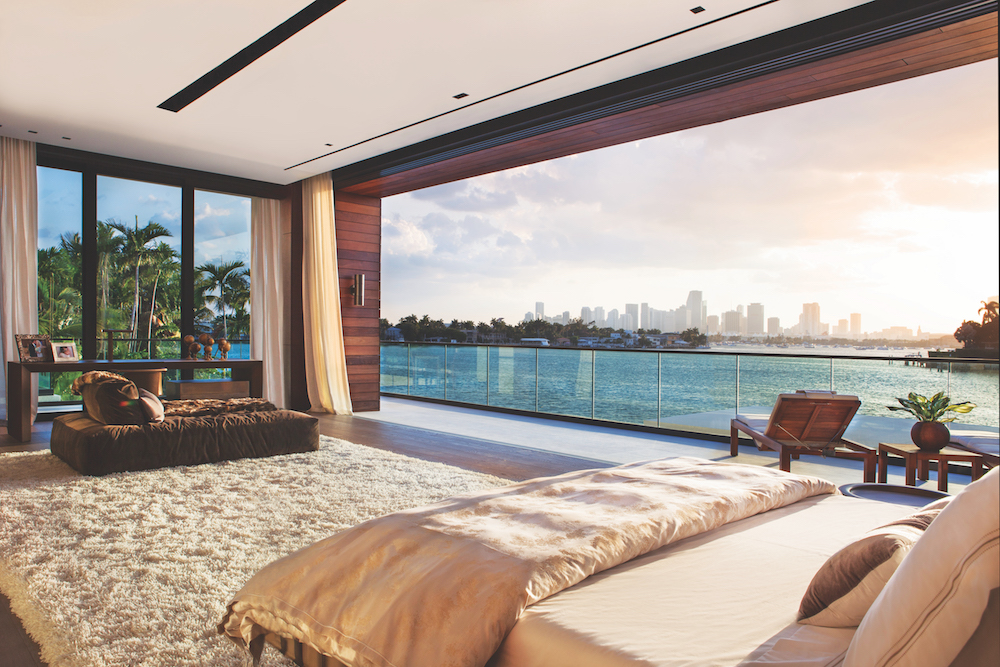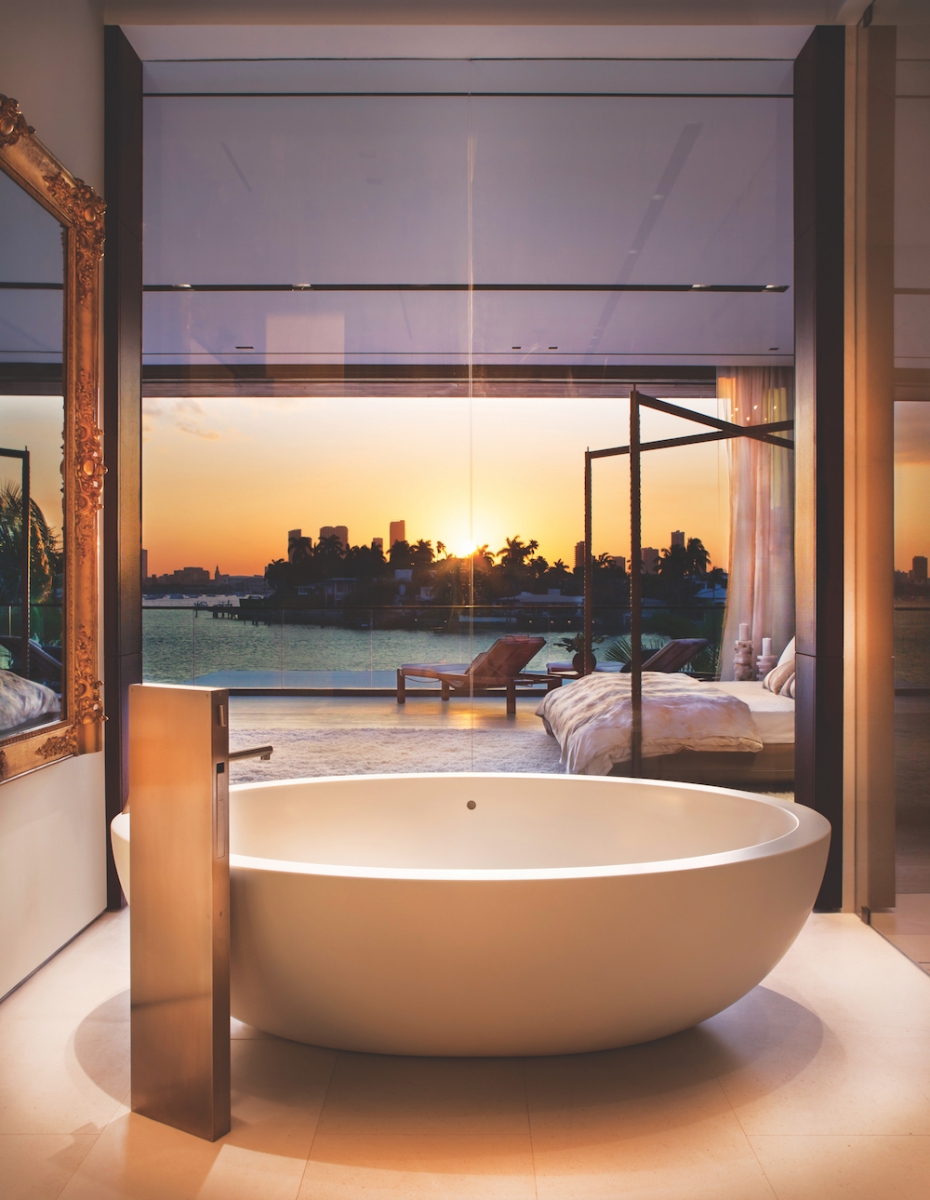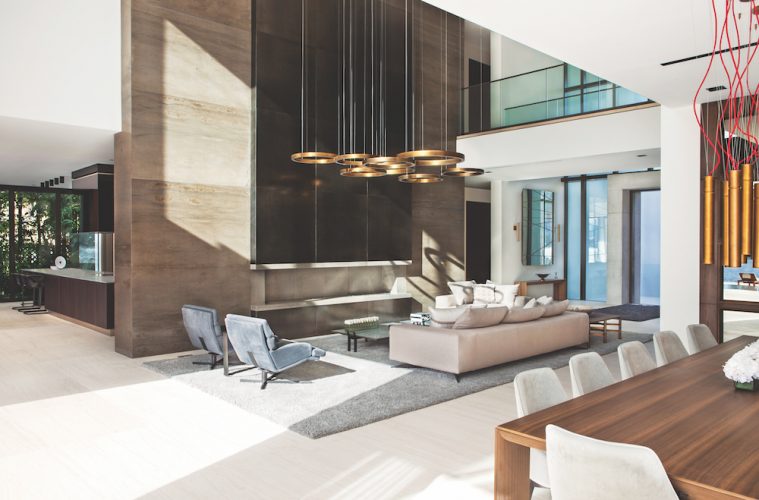A head-turning new home at 212 West Dilido Drive on the Venetian Islands is breathing in the rarified air of high-end Miami Beach real estate.
“There are ten homes here selling for upwards of $25 million, and this one is getting multiple offers,” says owner and developer Ahmad Khamsi. “There’s an annual sell rate of just two homes a year because there are very few people who have $25 million.”
Apparently, those who do are giving strong consideration to the property that Khamsi calls Dilido 212 – also known widely as Casa Clara – which is currently listed by Julian Johnston of Calibre International Realty for a cool $32 million.


That’s because it’s perched on an exclusive and highly coveted double lot with a southwest orientation that yields stunning views of Biscayne Bay and downtown Miami across 120 feet of shimmering waterfront.
The home features 11,500 square feet of luxury living space on two levels, with seven bedrooms, nine baths, two powder rooms and three kitchens – two inside and one out. It’s also packed with designer names, such as Boffi (the baths and kitchens), Kreon (the architectural lighting) and custom furniture by Henge.
Not to mention elegant interior design by Charlotte Dunagan Design Group and eye-popping contemporary architecture by Ruben Gomez and Ralph Choeff, founder and principal of award-winning Choeff Levy Fischman based in Miami.
Their work is in a style that Choeff calls Tropical Modern – known for blurring the lines between inside and out, and extremely popular across South Florida. “There isn’t an island or a street here that doesn’t have a Ralph Choeff home on it,” Khamsi says.
Khamsi began interviewing architects three years ago, after envisioning the basic design for the house he wanted to build and then sell.
Choeff is well known in Florida as the architect who has designed icons like the Mondrian South Beach Hotel and The Angler’s on Miami Beach, as well as homes for major celebrities such as Cher, Matt Damon and Alex Rodriguez.


“He has no ego, and he was also open and inviting to our participation. We found him to be extremely patient and flexible,” says Khamsi. “He wanted his client to have the best home, and we are thrilled with his masterful interpretation of timeless and unique luxury.”
Choeff is a native of Havana, Cuba, who migrated with his family to Miami at the age of six, and then moved to Brooklyn, N.Y., eventually graduating from Pratt Institute’s architecture program in 1978.
Two weeks after graduation, he settled in Miami and went on to establish his own architectural firm in 1983. “I decided on a warm-weather climate,” Choeff says. “The decision was between Los Angeles and Miami, and I chose Miami.”
Since then, he and partners Raphael Levy and Paul Fischman have not only watched Miami grow from a small town into a world-class center of international business and tourism, they’ve also influenced the look and feel of a great deal of that expansion.
And they’ve done it in a style that draws on Bauhaus roots, with influences from modernists like Mies van der Rohe, Richard Neutra, Richard Meier, Gwathmey Siegel, Le Corbusier and Arquitectonica.
“Most people understand midcentury modern architecture, and this is Florida’s version of it,” Choeff says of Dilido 212. “We used materials that are common to this region – ipe wood that’s termite- and decay-resistant, porcelain stone and natural concrete – with a floor that’s limestone and wood.”
Ruben Gomez came to the project at the request of Khamsi. He’d left Choeff Levy Fischman two years before, after working with the award-winning firm for seven years.
Gomez credits Richard Neutra for the inspiration of Dilido 212’s design. “Ralph and I have always loved Neutra,” he says. “He saw open and exposed spaces and connected them – it’s very important for the main feeling of the house.”
.jpg)
.jpg)
Khamsi’s concept for Choeff and Gomez was for a high-end private residence with the finest finishes, and he pushed them, he says, to create the most fascinating and interesting home they could.
“He asked us to design a maximum square-foot-by-code home, and he was very specific about the number of bedrooms, the catering kitchen in addition to a regular kitchen, and the very large doors to blur the line between inside and out,” says Choeff.
Then there was the garage. “He said the garage needed to be a car suite,” Gomez says. “So we came up with a four-car garage for a Rolls-Royce – nobody in South Florida has anything like that.”
Khamsi, however, understood that the grand, sweeping vistas would be key to the success of the project, as would its cinematic approach.
A visitor first entering the home sees a water feature cascading into a reflecting pool that, when illuminated at night, gives the impression of sparkling fire. A massive pivoting door, the centerpiece of the main entry, opens to a hallway with cantilevered stairs.
From there, the visual fireworks commence, big-time. “The first thing you see is the Biscayne Bay water view, and when the sliding glass doors are open, you feel like you’re entering the lobby of a hotel in the Caribbean,” Choeff says. “You’re inside, but you feel like you’re outside.”
.jpg)
.jpg)
With both the pivoting entrance and sliding glass doors open, there’s a water view at each end, a fountain out front and the bay to the southwest. Moreover, the architects designed the home for cross-ventilation, so all the doors can be open all summer long.
The wind from across the bay cools the air temperature inside, creating a microclimate. “The effect is fantastic – it’s a slow but chill wind, and that’s a good thing,” says Gomez. “It’s very difficult to live in a house in Miami in the summer, so that’s very important.”
The peak hours for intense South Florida summer sun are between 4 P.M. and 7 P.M., so the cross-ventilation was balanced with extended overhangs for shade as well as the orientation of the views.
“We shifted the home’s axis to provide the views,” adds Gomez. “The first floor is open – inside you’ll never see an enclosure – and the kitchen has three panels of windows with 32 feet of open space. The circulation is always open, and you’ll never get bored because of the views.”
.jpg)
.jpg)
Those views are so accessible because of the shape of the 22,000-square-foot site. It’s much wider than it is deep, which is precisely the opposite of most Miami Beach lots that are long and narrow.
“The interesting thing is that the owner originally wanted to build on the northernmost lot but then purchased the southernmost lot,” Choeff says. “So instead of building two independent residences, he built one, and we advised him that it’s easier to sell one home than two.”
It’s a prized lot indeed, Khamsi says, enhanced by one of Choeff’s best designs to date. “It’s not often that a client pushes him to a higher level of design,” Khamsi says. “We constructed his dream house as well as ours. It’s the house he sends all his important clients to visit.”
When Khamsi builds his next house, Choeff and company are certain to be involved. But first comes the closing on Dilido 212: a three-year labor of love that’s worth every cent of its asking price.
For more information, visit casaclaramiamibeach.com and clfarchitects.com.
SaveSave


